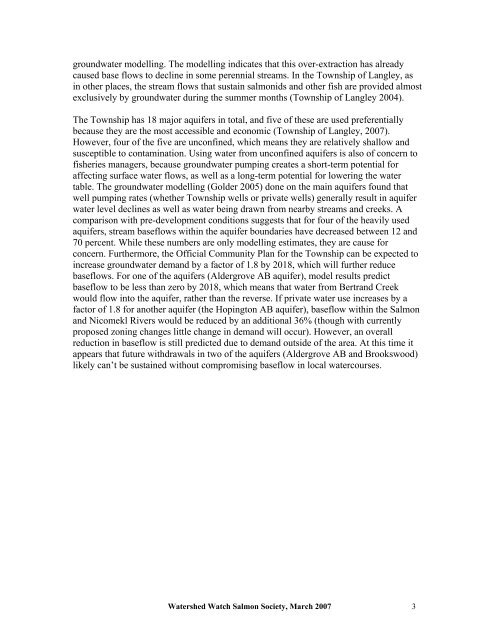Township of Langley Groundwater Management: Case Study
Township of Langley Groundwater Management: Case Study
Township of Langley Groundwater Management: Case Study
You also want an ePaper? Increase the reach of your titles
YUMPU automatically turns print PDFs into web optimized ePapers that Google loves.
groundwater modelling. The modelling indicates that this over-extraction has already<br />
caused base flows to decline in some perennial streams. In the <strong>Township</strong> <strong>of</strong> <strong>Langley</strong>, as<br />
in other places, the stream flows that sustain salmonids and other fish are provided almost<br />
exclusively by groundwater during the summer months (<strong>Township</strong> <strong>of</strong> <strong>Langley</strong> 2004).<br />
The <strong>Township</strong> has 18 major aquifers in total, and five <strong>of</strong> these are used preferentially<br />
because they are the most accessible and economic (<strong>Township</strong> <strong>of</strong> <strong>Langley</strong>, 2007).<br />
However, four <strong>of</strong> the five are unconfined, which means they are relatively shallow and<br />
susceptible to contamination. Using water from unconfined aquifers is also <strong>of</strong> concern to<br />
fisheries managers, because groundwater pumping creates a short-term potential for<br />
affecting surface water flows, as well as a long-term potential for lowering the water<br />
table. The groundwater modelling (Golder 2005) done on the main aquifers found that<br />
well pumping rates (whether <strong>Township</strong> wells or private wells) generally result in aquifer<br />
water level declines as well as water being drawn from nearby streams and creeks. A<br />
comparison with pre-development conditions suggests that for four <strong>of</strong> the heavily used<br />
aquifers, stream baseflows within the aquifer boundaries have decreased between 12 and<br />
70 percent. While these numbers are only modelling estimates, they are cause for<br />
concern. Furthermore, the Official Community Plan for the <strong>Township</strong> can be expected to<br />
increase groundwater demand by a factor <strong>of</strong> 1.8 by 2018, which will further reduce<br />
baseflows. For one <strong>of</strong> the aquifers (Aldergrove AB aquifer), model results predict<br />
baseflow to be less than zero by 2018, which means that water from Bertrand Creek<br />
would flow into the aquifer, rather than the reverse. If private water use increases by a<br />
factor <strong>of</strong> 1.8 for another aquifer (the Hopington AB aquifer), baseflow within the Salmon<br />
and Nicomekl Rivers would be reduced by an additional 36% (though with currently<br />
proposed zoning changes little change in demand will occur). However, an overall<br />
reduction in baseflow is still predicted due to demand outside <strong>of</strong> the area. At this time it<br />
appears that future withdrawals in two <strong>of</strong> the aquifers (Aldergrove AB and Brookswood)<br />
likely can’t be sustained without compromising baseflow in local watercourses.<br />
Watershed Watch Salmon Society, March 2007 3
















